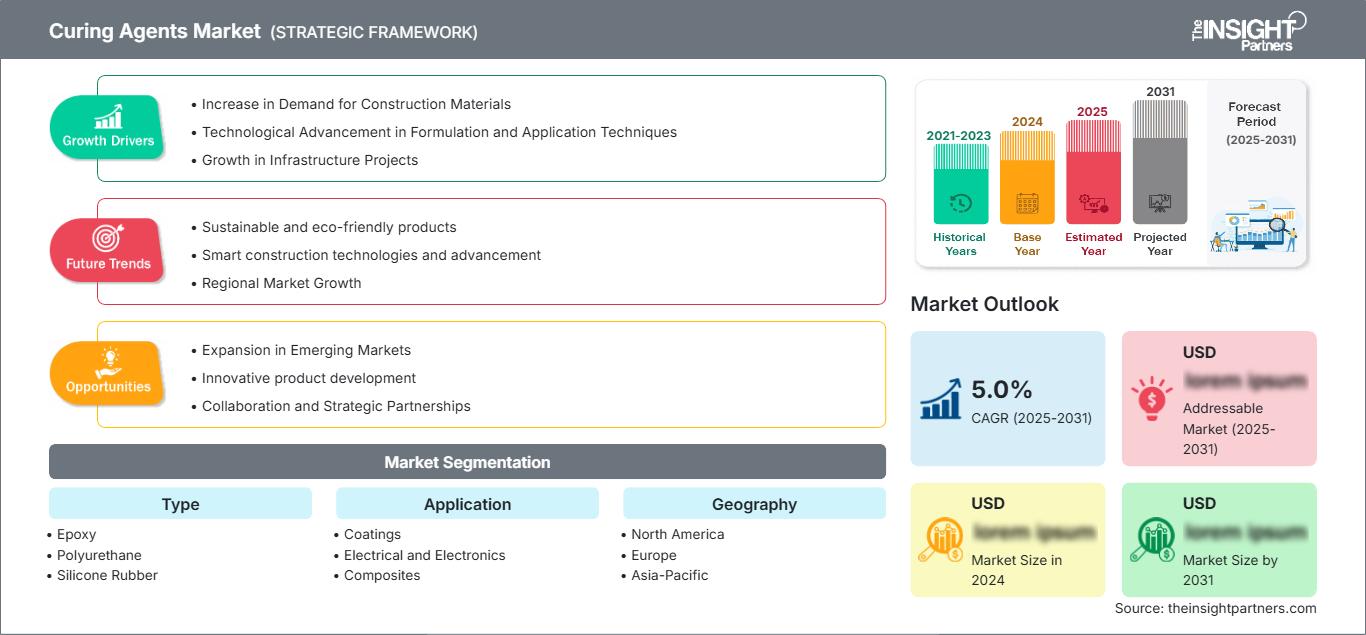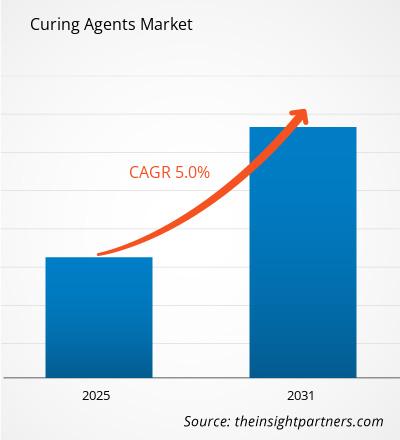Si prevede che il mercato degli agenti indurenti registrerà un CAGR del 5,0% dal 2025 al 2031, con una dimensione del mercato in espansione da XX milioni di dollari nel 2024 a XX milioni di dollari entro il 2031.
Il mercato degli agenti indurenti è segmentato per tipologia, applicazione e area geografica. In base alla tipologia, il mercato è segmentato in epossidico, poliuretano, gomma siliconica e altri. In base all'applicazione, il mercato è segmentato in rivestimenti, prodotti elettrici ed elettronici, compositi, adesivi, edilizia, energia eolica e altri. L'ambito del rapporto copre cinque regioni: Nord America, Europa, Asia-Pacifico, Medio Oriente e Africa, America Meridionale e Centrale e i principali paesi di ciascuna regione. L'analisi globale è ulteriormente suddivisa a livello regionale e per i principali paesi. Il rapporto offre il valore in USD per l'analisi e i segmenti sopra indicati.
Scopo del rapporto
Il rapporto "Curing Agents Market" di The Insight Partners mira a descrivere il panorama attuale e la crescita futura, i principali fattori trainanti, le sfide e le opportunità. Ciò fornirà spunti a vari stakeholder aziendali, come:
- Fornitori/Produttori di tecnologia: per comprendere le dinamiche di mercato in evoluzione e conoscere le potenziali opportunità di crescita, consentendo loro di prendere decisioni strategiche informate.
- Investitori: per condurre un'analisi completa delle tendenze in merito al tasso di crescita del mercato, alle proiezioni finanziarie di mercato e alle opportunità esistenti lungo la catena del valore.
- Organismi di regolamentazione: per regolamentare le politiche e le attività di controllo sul mercato con l'obiettivo di ridurre al minimo gli abusi, preservare la fiducia degli investitori e sostenere l'integrità e la stabilità del mercato.
Tipo di segmentazione del mercato degli agenti indurenti
- Epossidico
- Poliuretano
- Gomma siliconica
Applicazione
- Rivestimenti
- Elettrico ed elettronico
- Compositi
- Adesivi
- Edilizia
- Energia eolica
Potrai personalizzare gratuitamente qualsiasi rapporto, comprese parti di questo rapporto, o analisi a livello di paese, pacchetto dati Excel, oltre a usufruire di grandi offerte e sconti per start-up e università
Mercato degli agenti di polimerizzazione: Approfondimenti strategici

- Ottieni le principali tendenze chiave del mercato di questo rapporto.Questo campione GRATUITO includerà l'analisi dei dati, che vanno dalle tendenze di mercato alle stime e alle previsioni.
Fattori di crescita del mercato degli agenti indurenti
- Aumento della domanda di materiali da costruzione: il settore edile in tutto il mondo sta registrando una forte crescita grazie all'urbanizzazione, alle infrastrutture e a ulteriori sviluppi per abitazioni e altri edifici commerciali. Gli agenti indurenti svolgono un ruolo importante nel migliorare il calcestruzzo e altri materiali da costruzione in termini di durabilità, resistenza e durata. Pertanto, si prevede che la domanda effettiva di agenti indurenti aumenterà di pari passo con l'attività edilizia globale.
- Progresso tecnologico nelle tecniche di formulazione e applicazione: i cambiamenti nel mercato sono dovuti ai progressi nelle tecniche di formulazione e applicazione degli agenti indurenti. Gli agenti indurenti ecologici e ad alte prestazioni, che riducono al minimo l'impatto ambientale migliorando al contempo l'efficienza, stanno guadagnando attenzione. L'enfasi sulle pratiche di costruzione sostenibili e il passaggio a metodi di costruzione a basso consumo energetico stanno incoraggiando i produttori a impegnarsi nella ricerca e sviluppo che porta all'emergere di soluzioni di indurimento avanzate.
- Crescita nei progetti infrastrutturali: la crescita delle infrastrutture ha ricevuto maggiore attenzione e investimenti significativi in progetti infrastrutturali nella maggior parte delle economie in via di sviluppo, il che ha trainato in larga misura il mercato degli agenti indurenti. La maggior parte dei progetti di smart city, delle reti di trasporto e degli impianti di energia rinnovabile richiede materiali ad alte prestazioni per soddisfare elevati standard di qualità e durata.
Tendenze future del mercato degli agenti indurenti
- Prodotti sostenibili ed ecocompatibili: la tendenza all'edilizia sostenibile è in crescita; pertanto, sono richiesti nuovi agenti indurenti ecocompatibili. I produttori stanno formulando agenti indurenti a base d'acqua, di origine biologica e a basso contenuto di COV per rispondere sia ai requisiti delle normative ambientali sia alle aspirazioni dei consumatori consapevoli.
- Tecnologie e progressi nell'edilizia intelligente: l'applicazione di tecnologie intelligenti nel processo di costruzione è uno dei progressi. Gli agenti indurenti vengono utilizzati per essere monitorati e controllati dai sistemi di monitoraggio IoT. Ciò rientra nella più ampia tendenza verso pratiche di costruzione basate sui dati, migliorando così i processi di polimerizzazione e le prestazioni dei materiali.
- Crescita del mercato regionale: Asia-Pacifico, America Latina e Medio Oriente si stanno sviluppando a un ritmo rapido grazie alle economie in via di sviluppo. Le regioni si stanno orientando maggiormente verso lo sviluppo infrastrutturale, il che aumenta il livello di domanda di polimerizzanti, integrato da afflussi di investimenti esteri e unità produttive create da attori globali per soddisfare le esigenze locali.
Opportunità di mercato per i polimerizzanti
- Espansione nei mercati emergenti: Questa è l'area più promettente per l'espansione nei mercati emergenti, dove si sta verificando una rapida crescita dell'urbanizzazione e dei progetti infrastrutturali. Le aziende potrebbero trarre vantaggio dall'aumento della domanda costruendo impianti di produzione all'interno delle regioni e distribuendo prodotti per soddisfare specifiche esigenze locali.
- Sviluppo di prodotti innovativi: Grandi opportunità per innovare nuove formulazioni di polimerizzanti per soddisfare mercati di nicchia molto piccoli, come i polimerizzanti per applicazioni ad alte prestazioni in condizioni meteorologiche estreme. Questi prodotti, che offrono un ulteriore vantaggio, come una polimerizzazione più rapida o prestazioni migliorate a basse temperature, possono soddisfare una quota sostanziale del mercato.
- Collaborazione e partnership strategiche: esiste anche la possibilità di scoprire nuove opportunità per l'introduzione di agenti indurenti, grazie alla collaborazione con imprese edili, architetti e fornitori di materiali. Le partnership strategiche favoriscono l'introduzione di nuovi prodotti sul mercato, aumentandone la visibilità tra i clienti target e, di conseguenza, la crescita delle vendite.
Approfondimenti regionali sul mercato degli agenti di polimerizzazione
Le tendenze regionali e i fattori che influenzano il mercato degli agenti di polimerizzazione durante il periodo di previsione sono stati ampiamente spiegati dagli analisti di The Insight Partners. Questa sezione illustra anche i segmenti e la geografia del mercato degli agenti di polimerizzazione in Nord America, Europa, Asia-Pacifico, Medio Oriente e Africa, America Meridionale e Centrale.
Ambito del rapporto di mercato sugli agenti di polimerizzazione
| Attributo del rapporto | Dettagli |
|---|---|
| Dimensioni del mercato in 2024 | US$ XX million |
| Dimensioni del mercato per 2031 | US$ XX Million |
| CAGR globale (2025 - 2031) | 5.0% |
| Dati storici | 2021-2023 |
| Periodo di previsione | 2025-2031 |
| Segmenti coperti |
By Tipo
|
| Regioni e paesi coperti | Nord America
|
| Leader di mercato e profili aziendali chiave |
|
Densità degli operatori del mercato degli agenti di polimerizzazione: comprendere il suo impatto sulle dinamiche aziendali
Il mercato degli agenti indurenti è in rapida crescita, trainato dalla crescente domanda da parte degli utenti finali, dovuta a fattori quali l'evoluzione delle preferenze dei consumatori, i progressi tecnologici e una maggiore consapevolezza dei benefici del prodotto. Con l'aumento della domanda, le aziende stanno ampliando la propria offerta, innovando per soddisfare le esigenze dei consumatori e sfruttando le tendenze emergenti, alimentando ulteriormente la crescita del mercato.

- Ottieni il Mercato degli agenti di polimerizzazione Panoramica dei principali attori chiave
Punti di forza
- Copertura completa: il rapporto analizza in modo esaustivo prodotti, servizi, tipologie e utenti finali del mercato degli agenti indurenti, offrendo una panoramica olistica.
- Analisi degli esperti: il rapporto è redatto sulla base della conoscenza approfondita di esperti e analisti del settore.
- Informazioni aggiornate: il rapporto garantisce la pertinenza aziendale grazie alla copertura di informazioni e dati recenti.
- Opzioni di personalizzazione: questo rapporto può essere personalizzato per soddisfare le esigenze specifiche del cliente e adattarsi in modo appropriato alle strategie aziendali.
Il rapporto di ricerca sul mercato degli agenti indurenti può quindi contribuire a guidare il percorso di decodificazione e comprensione dello scenario del settore e delle prospettive di crescita. Sebbene possano esserci alcune preoccupazioni valide, i vantaggi complessivi di questo rapporto tendono a superare gli svantaggi.
- Analisi storica (2 anni), anno base, previsione (7 anni) con CAGR
- Analisi PEST e SWOT
- Valore/volume delle dimensioni del mercato - Globale, Regionale, Nazionale
- Industria e panorama competitivo
- Set di dati Excel
Report recenti
Testimonianze
Motivo dell'acquisto
- Processo decisionale informato
- Comprensione delle dinamiche di mercato
- Analisi competitiva
- Analisi dei clienti
- Previsioni di mercato
- Mitigazione del rischio
- Pianificazione strategica
- Giustificazione degli investimenti
- Identificazione dei mercati emergenti
- Miglioramento delle strategie di marketing
- Aumento dell'efficienza operativa
- Allineamento alle tendenze normative




















 Ottieni un campione gratuito per - Mercato degli agenti di polimerizzazione
Ottieni un campione gratuito per - Mercato degli agenti di polimerizzazione